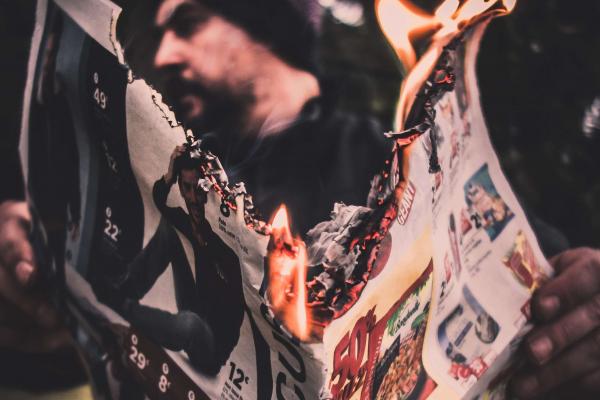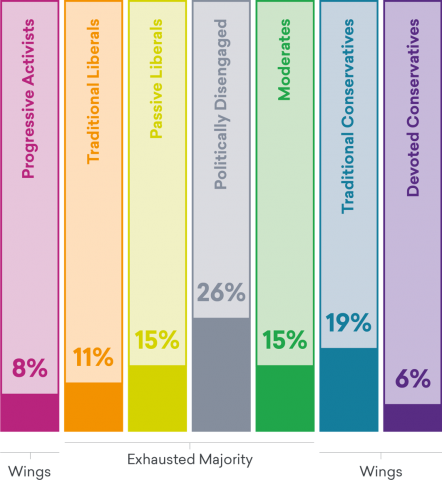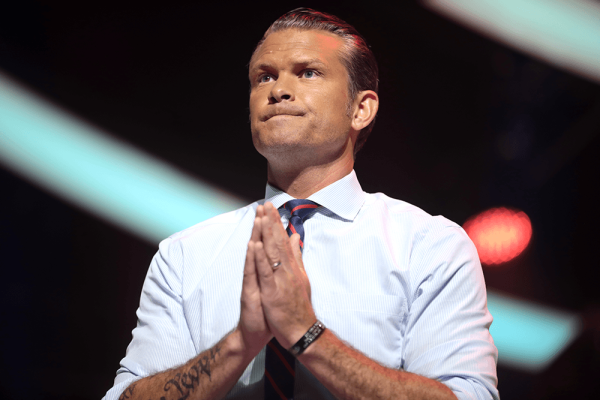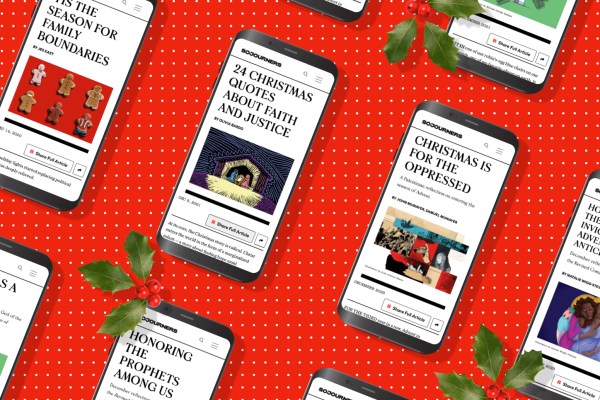Energetic political debate is a hallmark of American democracy. But in recent years, our politics seems to have gone off the rails. Liberals and conservatives have become deeply suspicious not just of each other’s beliefs, but even their motivations. Disagreement has turned into deep division. Political violence has been openly sanctioned by the president.
Politics has always involved disagreements, but it’s not the same as it ever was in today’s United States. Something has changed. In a national survey we at More in Common conducted last month, fully 87 percent of Americans said that they feel the country is more divided than at any point in their lifetimes.
Of course polarization did not begin with the Trump presidency: For many years, studies have shown a decline in social trust. But no president in living memory has so brazenly sought to divide the country into “us” versus “them.” Institutions and individuals that have sought to stand apart from America’s partisan conflicts, from intelligence agencies and election authorities to courts and respected media outlets, are cast as allies or enemies. Americans feel as if they are being walled in by political and cultural conflicts that run through every dimension of life: in their Facebook feeds, on television, at work, even in church and sports, and all the way to the family dinner table at Thanksgiving.
It’s against this backdrop that we launched More in Common’s Hidden Tribes project, a year-long project to understand better what is pulling us apart, and find what can bring us back together.
More in Common’s focus is not the political conflicts that are playing out on the centerstage of national debates, but the American people themselves. To understand the state of the nation, we have swung the camera away from centerstage and onto the crowd itself. For the past year, we have worked with global public opinion research firm YouGov to survey 8,000 Americans, fully representative of the country’s adult census population of American citizens. We have so far conducted three phases of surveys, as well as a series of focus group discussions and one-to-one conversations with a wide cross-section of individuals. The 150-page landmark study can be downloaded at the Hidden Tribes website.
The issues we have explored in the surveys and conversations range widely. We have learned about how Americans are feeling about society and politics; their circumstances and aspirations; their values; their sense of identity; what media they read, watch or listen to; and their views on a range of current issues including immigration, racial justice, gender, American identity, and terrorism. We even asked about how often they pray or go to church. To our knowledge, the Hidden Tribes report is the largest study ever of polarization and Americans' deeper values and beliefs.
After asking all of these questions, the data science team at YouGov conducted a detailed analysis to find similarities in individuals’ responses. This exercise clustered Americans into seven main groups. Importantly, the analysis steered clear of the common ways of grouping Americans according to divisions based on their party identity, racial background, gender, or age. None of those factors were used to create the segments (or “tribes”), nor did we use any questions relating to current political issues. Instead, people were grouped on the basis of their core beliefs, their sense of identity, and how engaged they are in political issues, using a set of questions informed by social psychology.
The result is a fresh and different snapshot of American society. Despite what we hear from the media and politicians, the United States is not a country divided into two opposing groups. While factors such as race, gender, age, and class play an important role, there is much more diversity of belief than media debates often assume. In each of the seven segments, there are people of every race, gender, age, and class. And we can predict a person’s views on most current political debates more reliably by the tribe to which they belong, than grouping them by race, gender, age, class, or even what party they support.
On the left end of the spectrum we found two groups:
- Progressive Activists, who comprise 8 percent of the population. They are highly educated, cosmopolitan in their values, very politically active on social media, tend to be younger, and are especially sensitive to issues of oppression and unjust power structures. They are by far the most secular group (only 24 per cent say that religion is important to their lives, compared to 63 percent of Americans as a whole).
- Traditional Liberals make up 11 percent. They have strong liberal values and they are politically active, but they are more open to compromise and more cautious than the Progressive Activists. Many are from the baby boomer generation.
On the right end of the spectrum we also found two groups:
- Devoted Conservatives, who comprise 6 percent of the population. They are very politically active, including on social media, and very strident. They are typically older, are very proud of their American identity, support President Trump, and believe traditional values are under assault from a radical liberal agenda. Some 38 percent describe themselves as born-again evangelicals, more than any other segment. They are the only group who say that it is more important to rid the nation of evil than to heal the nation’s divisions.
- Traditional Conservatives, who make up 19 percent of the population. They are politically engaged and like the Devoted Conservatives, tend to think America is now going in the right direction. They are patriotic and religious, and emphasize personal responsibility and self-reliance. in their beliefs and behavior they are not as intense as the Devoted Conservatives.
Between these two sides we found three groups:
- Passive Liberals, who make up 15 percent of the population. They hold generally liberal views, but they are much less politically active. They lack the confidence that they can make a difference by voting or engaging in political debates. They have lower incomes and lower education; they are younger; they are more likely to be female; and they more racially diverse. They tend to feel insecure and disillusioned.
- The Politically Disengaged is the largest single group, comprising 26 percent of the population. This group is quite similar in its makeup to the Passive Liberals: lower education, lower income, and racially diverse. But they are even less engaged in politics than the Passive Liberals. They have very low levels of trust in institutions and in other people, and are noticeably more opposed to immigration.
- Moderates, who make up 15 percent of Americans. They are civically minded and engaged in politics. They tend to be socially conservative and compassionate. They dislike the tone of politics right now and they strongly disapprove of President Trump. They are very middle-of-the-road, and in the midterm elections this group appears to have played a major role in swinging suburban congressional districts to the Democrats.
When we asked about the most serious problems facing the United States, we were struck by how often people talked about polarization. A deep sense of division is affecting Americans’ lives directly in ways that many have not experienced before. These concerns are voiced by people in all seven groups, but especially people less engaged in partisan politics. Yet despite this deep sense of division, an overwhelming majority of 77 percent of Americans say that our differences are not so great that we cannot come together.
This is where we found a different fault line in America’s politics, between what we call the Wing groups and the Exhausted Majority. The Wing groups see most of today's major debates in us-versus-them terms. They rely on politically partisan media sources that constantly report the extremes of their political opponents. They tend to believe the other side are bad people with evil motivations. They also tend to dominate the debate on social media and cable television, because their more extreme views grab people's attention and provoke conflict. The Wings comprise 33 percent of Americans, and they are often very different from the rest of the country. For example, the Progressive Activists are the only group who do not believe that political correctness has gone too far; similarly, the Traditional and Devoted Conservatives are the only groups who approve of Donald Trump’s performance as president, and believe that the country is heading in the right direction.
In contrast to the Wings, the Exhausted Majority comprises 67 per cent of the population (the Traditional Liberals, Passive Liberals, Politically Disengaged, and Moderates). While they hold a range of political views, they are united in main three ways:
- They dislike tribalism and are fed up with America’s polarization. They believe that Americans have more in common than that which divides them.
- They feel forgotten by the political process, and that their voices are rarely heard above the shouts of the others.
- They have a more flexible and less ideological approach to issues than the partisans of both the left and right. They feel that compromise is necessarily in politics as in other areas of life.
The Exhausted Majority gives us hope. Yet the forces that are driving polarization and social fracturing are profoundly powerful: from rising inequality and economic insecurity, to social media echo chambers, and the bewildering pace of social and demographic change. All this is happening against a backdrop of fears of crime and terrorism, which further heighten people’s perception of threat and accelerate their retreat into their tribal identities.
Authoritarian populists across the world see this as a moment ripe with opportunity to take power. These forces are in play not just in the United States but across the world, as More in Common’s national studies in other European countries have also shown. They are much greater than any individual president, prime minister, campaign, or media organization, and these pressures are intensifying.
Combating us-versus-them tribalism and far-right populism is not easy. It may be one of the greatest social and political challenges of our age. But there will be no sustained progress on racial, economic, and environmental justice without overcoming this tribalism. Just consider how partisanship has prevented progress even on modest and publicly supported proposals for immigration reform and gun control. And the victims of far-right populism are so often the “least of these” – just think of refugees in Europe, or the children who were divided from their families on the U.S. southern border this past summer.
In this climate, the work of Sojourners and faith communities has never been more vital. Deep divisions are troubling the soul of the nation, and religious belief remains important for most Americans. Yet religion is often part of this tribal conflict, rather than part of its resolution. America needs churches and faith leaders who can bring a prophetic ministry of reconciliation, and a vision for a more united America where everyone has dignity and respect: what Martin Luther King spoke of as the beloved community. The warriors of both sides — both the secular Progressive Activists on the one hand, and the religiously tribal Devoted Conservatives on the other — cannot unify the country, because they do not understand it and do not want to heal it. What is needed today are leaders at every level who will stand in the gap and bring people together, across all the lines that are dividing Americans.
Some say we are entering a new “Cold Civil War”: not a cold war between America and an external enemy, but a war between Americans. And with so many flashpoints ahead in national politics, there are real dangers that this war heats up. In this time of polarization, we need to mobilize churches and faith leaders inspired by the peacemaking vision of the prophet Isaiah: a vision to turn the swords and spears now being used against each other, on social media and in public debate, into the plowshares and pruning hooks so that all can flourish in a peaceful and secure future. That vision may seem far away today, but it is only with such a vision that the forces of unity can overcome the forces of division.
Got something to say about what you're reading? We value your feedback!






